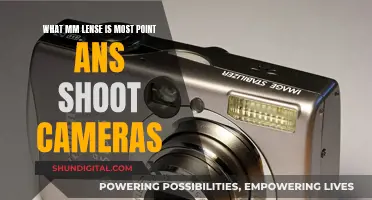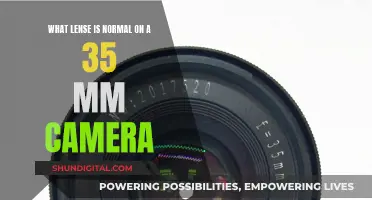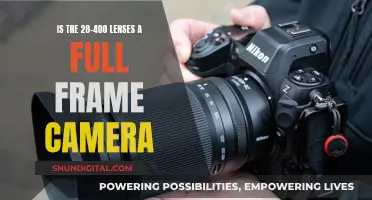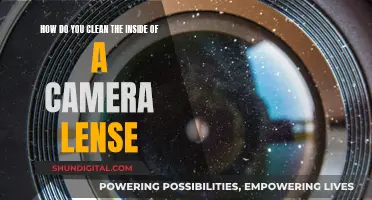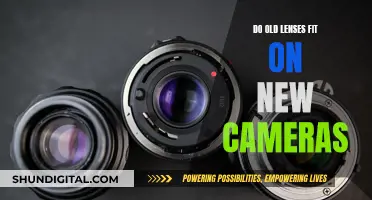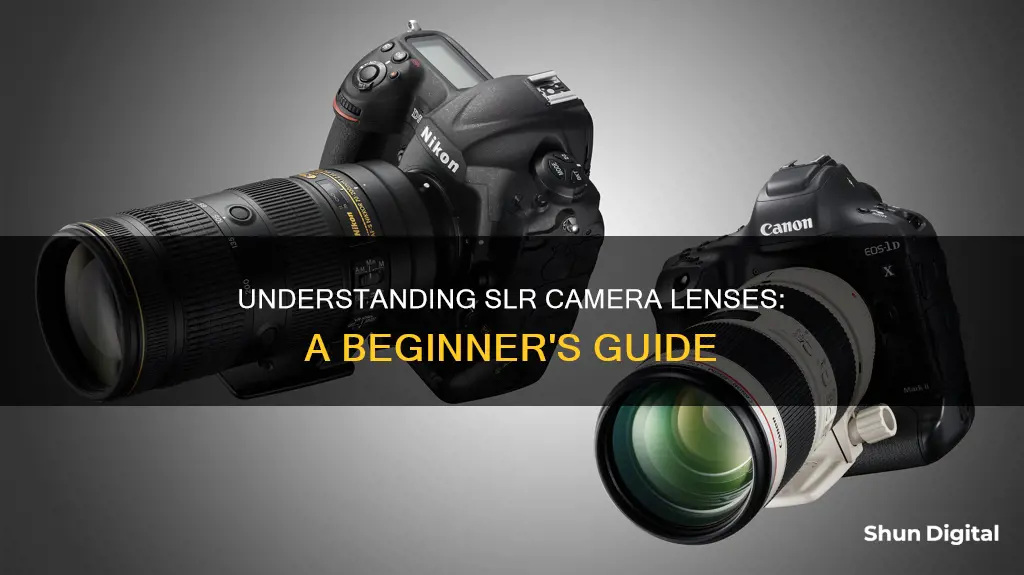
SLR stands for Single-Lens Reflex, referring to the way these cameras work. When the shutter button is pressed, a mirror flips out of the way to reveal the sensor, allowing the photographer to see what the lens sees and will be captured through the camera's optical viewfinder. SLR cameras are versatile and allow for a variety of lens choices, such as wide-angle, telephoto, or macro lenses. They are a popular choice for photographers seeking control and precision in their work.
| Characteristics | Values |
|---|---|
| Type of Camera | Single-lens reflex camera (SLR) |
| Technology | Single-lens reflex technology |
| Viewing Mechanism | Optical viewfinder |
| Image Capture | See what the lens sees and will capture |
| Image Storage | Film or memory cards |
| Image Quality | High-quality photos |
| Image Resolution | 12mb and higher |
| Lens | Detachable, interchangeable |
| Manual Settings | More control, e.g. exposure |
| Shutter Speed | Near-zero lag time |
| Weight | Heavier than mirrorless cameras |
| Battery Life | Better than mirrorless cameras |
| Usage | Versatile, suitable for various photography styles |
| Users | Professionals, amateurs, recreational and professional shooters |
What You'll Learn

SLR camera lenses and focusing
SLR, or Single-Lens Reflex cameras, are a popular choice for photographers who want control and precision in their photography. The key component in SLR cameras is the optical viewfinder, which enables the photographer to see the exact framing and exposure of the shot before capturing the image. This is achieved through the use of a mirror and prism system, which reflects light from the lens into the optical viewfinder. The viewfinder's accuracy results from the focusing screen, which displays the image as it will appear in the final photograph. This feature ensures that the desired depth of field and focus are captured.
SLR cameras are highly versatile when it comes to lens choices, with options such as wide-angle, telephoto, or macro lenses available to suit specific photography needs. The focusing process can be further enhanced by the camera's autofocus system, which includes methods such as contrast detection, phase detection, and hybrid systems. Alternatively, the photographer can choose to manually focus the lens for greater control.
The fundamental mechanism of an SLR camera revolves around the unique mirror and prism system. When a photograph is taken, light passing through the lens is intercepted by a reflex mirror, which reflects the incoming light onto a ground-glass focusing screen. This ensures that the image seen through the viewfinder is exactly what will be captured. Additionally, the pentaprism in the SLR camera corrects the image's lateral reversal on the focusing screen, providing a clear and accurate preview of the composition.
During exposure, the reflex mirror flips up and out of the way, revealing the sensor or film behind it. The shutter then opens, exposing the sensor or film to light, and finally closes to complete the image capture process. This system ensures accuracy in composition, focus, and exposure, making SLR cameras a popular choice among photographers of all skill levels.
Camera Lenses: Do They Have an Expiry Date?
You may want to see also

Interchangeable lenses
The ability to swap out lenses is one of the most appealing features of SLR cameras. Both SLR and DSLR cameras use interchangeable lenses, allowing users to choose the best lens for their specific imaging needs and shooting style. This means that photographers can use a wide array of lenses to suit their needs, from standard zoom to telephoto zoom, wide-angle, macro, prime, and specialty lenses.
The ability to change lenses is especially useful when photographers need to adapt to different photographic situations. For example, a telephoto zoom lens is ideal for capturing nature shots or sporting events, while a wide-angle lens offers a maximum field of view, making it perfect for landscape photography or real estate agents who need to capture wide angles.
It's important to note that not all lenses are interchangeable with any camera. For instance, Canon lenses are designed specifically for Canon cameras and won't work with a Nikon or Sony camera body. While third-party mounting adapters are available, they may result in a loss of functionality, such as autofocus or automatic aperture control.
When investing in new lenses, it's crucial to consider the type of camera body you have and ensure compatibility to avoid damaging your equipment. Additionally, it's worth noting that some older lenses may not be fully compatible with modern camera bodies, and manual focus lenses will require manual focusing even when attached to an autofocus SLR.
Cleaning Camera Lenses: Removing Rubber Residue
You may want to see also

Optical viewfinder
An optical viewfinder (OVF) is a component of a camera that the photographer looks through to view the scene in front of the camera. In the case of an SLR camera, a mirror and a system of prisms are used to allow the photographer to see the scene as it appears through the lens. This is in contrast to a rangefinder, which uses its own lens to display an offset image of the scene being viewed.
The main advantage of an OVF is that it presents an unfiltered and unaltered view of the scene as you compose your shot. This means that the OVF image tends to look crisp and clear. Additionally, OVFs work even when the camera is turned off, and they have no issues with accurate colour rendition or screen refresh rates. They are also useful for action photography, as there is essentially zero lag when you look through the viewfinder.
However, one significant limitation of OVFs is that you cannot see the image when you take a picture, as the mirror in a DSLR camera flips up and out of the way to let light pass through to the image sensor. This is known as viewfinder blackout and can cause issues when shooting fast-moving subjects. Another disadvantage is that OVFs show you the world as it is, not as it will appear in your final photograph. This means that you may end up with images that are too bright or too dark.
Japan's Camera Lens Market: Affordable Photography Superpower?
You may want to see also

Image quality
The lens has the largest impact on the image quality of photographs taken with an SLR camera. The aperture of a lens is the opening that regulates the amount of light that passes through it, with a smaller f-number indicating a larger aperture and vice versa. A larger aperture (a smaller f-number) will have a shallow depth of field, resulting in a blurry background, while a smaller aperture (a larger f-number) will have a greater depth of field, keeping more of the image in focus.
The focal length of a lens, along with the size of the image sensor or film in the camera, determines the angle of view. A wide-angle lens has a shorter focal length and captures a wider scene, while a telephoto lens has a longer focal length and captures a smaller portion of the scene, making it seem closer. Zoom lenses have variable focal lengths, allowing photographers to adjust the angle of view without changing lenses. However, they typically have a lower maximum aperture than fixed-focal ("prime") lenses of the same weight and cost.
SLR cameras allow photographers to use a wide range of lenses, including those with extremely long focal lengths, which can be useful for wildlife, surveillance, or celebrity photography. The variety of lenses available for SLR cameras gives photographers greater control over their images and allows them to adapt to different situations.
In addition to the lens, the type of camera also affects image quality. Film cameras, such as SLRs, generally offer better image quality in terms of colour, contrast, and dynamic range than digital cameras. They also provide a higher-quality image with a larger negative size, which is easier to retouch if needed. However, digital cameras offer the convenience of storing thousands of images on memory cards and the ability to record videos.
UV Light: Friend or Foe to Camera Lenses?
You may want to see also

Instant image capture
Single-lens reflex (SLR) cameras have been a staple in the world of photography for decades. They are popular among photographers who want control and precision in their work. The key feature of an SLR camera is its use of a mirror and prism system, which allows the photographer to see exactly what will be captured through the lens. This enables better alignment and focus of the shot.
When a photograph is taken with an SLR camera, light passes through the lens and is reflected off a mirror onto the optical viewfinder. The photographer then uses the viewfinder to compose and focus the shot. During exposure, the mirror flips up, allowing light to reach the camera's sensor or film, thus capturing the image.
The optical viewfinder in an SLR camera provides a bright and clear view of the scene, which is particularly useful in low-light conditions or when using low-speed film. It is also unaffected by camera settings or changes in ambient light conditions, ensuring a consistent viewing experience.
The instant image capture in SLR cameras is made possible by the mirror and prism system. Here's how it works:
- When the shutter button is pressed, the mirror in the SLR camera flips up and out of the way.
- This movement of the mirror allows light to pass through the lens and reach the camera's sensor or film.
- The shutter then opens, exposing the sensor or film to light.
- Finally, the shutter closes, completing the image capture process.
This sequence of events occurs in a fraction of a second, resulting in instant image capture. The mirror mechanism ensures that the photographer sees the exact scene that will be captured, providing an accurate representation of the final image.
The SLR camera's ability to capture images instantly is a significant advantage, especially for photographers who need to react quickly to changing subjects or environments. This instant capture capability, combined with the precision offered by the mirror and prism system, makes SLR cameras a popular choice for many photographers, even in the era of digital photography and mirrorless cameras.
Camera Lenses for DSLRs: Are They Piratical and Affordable?
You may want to see also
Frequently asked questions
SLR stands for Single Lens Reflex.
The main difference is that DSLRs use digital sensors instead of photographic film. DSLRs also offer more advanced features and benefits, such as faster image processing, enhanced flexibility in image storage, and the ability to record video.
SLR cameras offer control and precision in photography. They allow photographers to see exactly what will be captured through the lens, providing better alignment and focus of the shot. SLR cameras also have interchangeable lenses, giving photographers the ability to adapt to different situations and specific photography needs.



